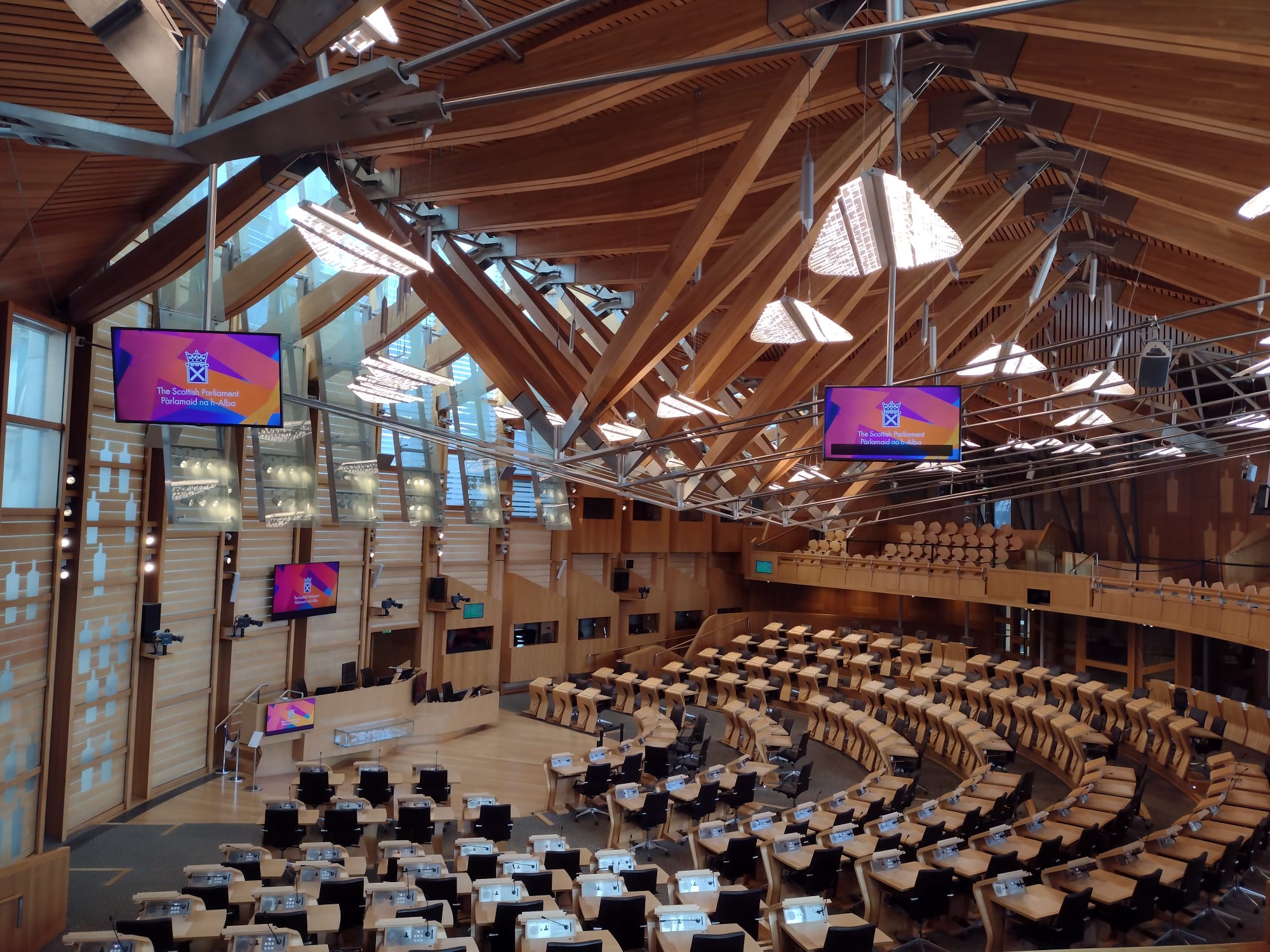Welcome to “Walking Woods Edinburgh”, a self-guided audio tour around the centre of Edinburgh that takes a closer look at the history of the city through the eyes of a wood scientist. The tour was developed as part of the 20th annual meeting of the Northern European Network for Wood Science and Engineering (WSE), but it is meant to be interesting for wood scientists and laypeople alike.
Go to the route map and list of stops
Download transcript of the episode.
In case you can’t visit the inside of the building today, this is what it looks like:

Jim and I are talking about Scottish hardwoods, and how hard it can be to actually get hold of them. The Association of Scottish Hardwood Sawmillers (ASHS) makes it easier to find sawmills local to you and procure the timber you need for your next project.
Even though now it is not exactly easy to procure hardwood in large quantities, hardwoods might become more important in the future, as more and more broadleaved woodlands have been planted since the 1980s. Especially in England, broadleaves make an incredibly important contribution to our woodlands, but this is not yet reflected in the timber harvest and construction industry. Building from England’s Woodlands is a project funded by the Forestry Commission that is working towards bringing more hardwoods into construction uses. We are looking at a wide range of species – more on that here.
Jim and I are also discussing the touchy subject of quality and quality perceptions of UK timber. It is a widespread myth that UK timber is “low quality” and even “not good enough to build with”. My colleagues and I hear these constantly, even from people close to the industry. And this is no wonder, when historic articles used such hard words to characterise home-grown timber:
There we come to the crux of the whole subject of using homegrown timber. As soon as we start to investigate our native timber, we find that while there is, thank heaven!, much well grown material in this country, there is a mass of stuff of miserable quality, the product of the grown-up slum children of British Forestry. – Home-grown Timber and Research (1941) [1]
In hardwoods we often still see this being a problem: Trees often don’t grow in a straight, uniform manner as is the case in many European countries. This is because tree form and timber yield don’t happen on accident, but are largely influenced by the forest management. And in the UK we have not really been managing our broadleaved forests for a few centuries now… An additional problem is posed by the immense deer population and the presence of grey squirrels, both of which damage predominantly broadleaf trees. If the trees survive the damage, their form is nevertheless impacted. Of course, gnarly trees have their own value for a woodland, but following a management plan has many advantages, including increased forest resilience and biodiversity, and growing some trees for timber harvest along the way can be one of the objectives. And forest owners do seem receptive to taking up management in their woodlands, so there is hope that we will have straighter trees in the future.
But small hardwood sawmills like Jim’s also saw less usual specimens and sell “character” pieces of hardwood for furniture and DIY. For a wood scientist it certainly is very hard to resist a piece of spalted beech or pippy oak…
Softwoods have found their way into managed, timber-producing woodlands on a large scale since the world wars. Their quality is nonetheless doubted by many. In softwoods the most widespread myth goes “the trees are grown too fast, therefore the wood has lower density, and therefore it is not strong.” (The myth is based on this theory). The short explanation of why this is untrue: Growth ring width is not a good predictor for density in basically any softwood species, and density is not a great predictor for mechanical properties anyway. Here is the much longer explanation (with evidence!).
It is true, however, that common UK softwoods, on the large, have slightly lower mechanical properties than softwoods that are imported from Scandinavia or Baltic countries. UK spruce readily grades to the strength class C16, while imported timber is commonly graded to C24. For many building purposes, like lowrise timber frame houses, C16 properties are more than enough. And timber of many UK species can be graded to C24 or higher strength classes as well, but the yield is higher when grading to lower strength classes. My colleagues and I are continuing to work on strength grading assignments for different UK timber species that work with a wide range of applications. Our job also involves convincing people to use UK timber when it is perfectly adequate for the job at hand. To quote again from the above mentioned article:
To sum is up, the job for research in homegrown timbers is not to try and make silk purses out of sows’ ears, but to see what job is there for sows’ ears and how the ears can be made suitable for them.
This concludes the Walking Woods Edinburgh tour. I hope you had fun and learned a bit about Scotland, history and wood.
[1] The article was found in the records of the Department for Scientific and Industrial Research (DSIR) in the National Archives
